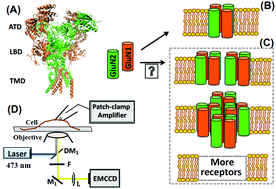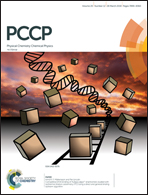Revealing dynamically-organized receptor ion channel clusters in live cells by a correlated electric recording and super-resolution single-molecule imaging approach†
Abstract
The N-methyl-D-aspartate (NMDA) receptor ion-channel is activated by the binding of ligands, along with the application of action potential, important for synaptic transmission and memory functions. Despite substantial knowledge of the structure and function, the gating mechanism of the NMDA receptor ion channel for electric on–off signals is still a topic of debate. We investigate the NMDA receptor partition distribution and the associated channel's open–close electric signal trajectories using a combined approach of correlating single-molecule fluorescence photo-bleaching, single-molecule super-resolution imaging, and single-channel electric patch-clamp recording. Identifying the compositions of NMDA receptors, their spatial organization and distributions over live cell membranes, we observe that NMDA receptors are organized inhomogeneously: nearly half of the receptor proteins are individually dispersed; whereas others exist in heterogeneous clusters of around 50 nm in size as well as co-localized within the diffraction limited imaging area. We demonstrate that inhomogeneous interactions and partitions of the NMDA receptors can be a cause of the heterogeneous gating mechanism of NMDA receptors in living cells. Furthermore, comparing the imaging results with the ion-channel electric current recording, we propose that the clustered NMDA receptors may be responsible for the variation in the current amplitude observed in the on–off two-state ion-channel electric signal trajectories. Our findings shed new light on the fundamental structure–function mechanism of NMDA receptors and present a conceptual advancement of the ion-channel mechanism in living cells.

- This article is part of the themed collection: 2018 PCCP HOT Articles


 Please wait while we load your content...
Please wait while we load your content...